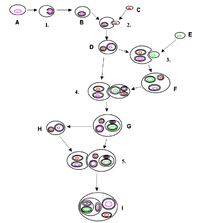Endosimbion

Endosimbion atau endobion[1] adalah organisme yang hidup di dalam tubuh atau sel organisme lain dalam hubungan saling menguntungkan yang disebut endosimbiosis (bahasa Yunani: ἔνδον endon "di dalam", σύν syn "bersama" dan βίωσις biosis "hidup"). Contohnya adalah bakteri pengikat nitrogen (yang disebut rhizobia) yang tinggal di dalam bintil akar legum, alga bersel tunggal di dalam koral, dan endosimbion bakteri yang menyediakan nutrien yang diperlukan oleh sekitar 10–15% serangga.
Banyak contoh endosimbiosis yang bersifat obligat; dalam kata lain, endosimbion dan inangnya tidak dapat bertahan hidup tanpa keberadaan yang lain, seperti cacing laut tanpa usus dari genus Riftia yang mendapat nutrisi dari bakteri endosimbiotik. Contoh lain adalah mitokondria dan kloroplas. Sementara itu, beberapa parasit dalam tubuh manusia (seperti Wuchereria bancrofti dan Mansonella perstans) dapat bertahan di inang perantara serangganya berkat simbiosis obligat dengan Wolbachia spp.
Dua organel utama dalam sel eukariot (yaitu mitokondria dan plastid seperti kloroplas) berasal dari endosimbion bakteri. Simbiogenesis seperti ini pertama kali diusulkan pada tahun 1905 dan dikemukakan oleh ahli botani Rusia Konstantin Mereschkowski pada tahun 1910.[2][3] Teori ini lalu dikembangkan oleh Lynn Margulis pada tahun 1960-an.
Catatan kaki
- ^ Margulis, Lynn; Chapman, Michael J. (2009). Kingdoms & domains an illustrated guide to the phyla of life on Earth (edisi ke-4th). Amsterdam: Academic Press/Elsevier. hlm. 493. ISBN 978-0-08-092014-6. Diakses tanggal 2 August 2016.
- ^ Mereschkowsky, Konstantin (1910). "Theorie der zwei Plasmaarten als Grundlage der Symbiogenesis, einer neuen Lehre von der Ent‐stehung der Organismen". Biol Centralbl. 30: 353‐367.
- ^ Mereschkowsky C (1905). "Über Natur und Ursprung der Chromatophoren im Pflanzenreiche". Biol Centralbl. 25: 593–604.
Daftar pustaka
- Dubilier N, Mülders C, Ferdelman T, et al. (May 2001). "Endosymbiotic sulphate-reducing and sulphide-oxidizing bacteria in an oligochaete worm". Nature. 411 (6835): 298–302. doi:10.1038/35077067. PMID 11357130.
- Burnett WJ, McKenzie JD (1 May 1997). "Subcuticular bacteria from the brittle star Ophiactis balli (Echinodermata: Ophiuroidea) represent a new lineage of extracellular marine symbionts in the alpha subdivision of the class Proteobacteria". Appl. Environ. Microbiol. 63 (5): 1721–4. PMC 168468
 . PMID 9143108.
. PMID 9143108. - Wernegreen JJ (2004). "Primer – Endosymbiosis: Lessons in Conflict Resolution". PLoS Biol. 2 (3): e68. doi:10.1371/journal.pbio.0020068. PMC 368163
 . PMID 15024418. Diarsipkan dari versi asli tanggal 14 April 2004.
. PMID 15024418. Diarsipkan dari versi asli tanggal 14 April 2004. - A general review of bacterial endosymbionts in insects. P. Baumann, N. A. Moran and L. Baumann, Bacteriocyte-associated endosymbionts of insects in M. Dworkin, ed., The prokaryotes, Springer, New York, 2000. http://link.springer.de/link/service/books/10125/
- Wernegreen JJ (November 2002). "Genome evolution in bacterial endosymbionts of insects". Nat. Rev. Genet. 3 (11): 850–61. doi:10.1038/nrg931. PMID 12415315.
- Douglas AE (January 1998). "Nutritional interactions in insect-microbial symbioses: Aphids and Their Symbiotic Bacteria Buchnera". Annual Review of Entomology. 43: 17–37. doi:10.1146/annurev.ento.43.1.17. PMID 15012383.
- Aksoy S, Maudlin I, Dale C, Robinson AS, O'Neill SL (January 2001). "Prospects for control of African trypanosomiasis by tsetse vector manipulation". Trends Parasitol. 17 (1): 29–35. doi:10.1016/S1471-4922(00)01850-X. PMID 11137738.
- Shigenobu S, Watanabe H, Hattori M, Sakaki Y, Ishikawa H (September 2000). "Genome sequence of the endocellular bacterial symbiont of aphids Buchnera sp. APS". Nature. 407 (6800): 81–6. doi:10.1038/35024074. PMID 10993077.
- Moran NA (April 1996). "Accelerated evolution and Muller's rachet in endosymbiotic bacteria". Proc. Natl. Acad. Sci. U.S.A. 93 (7): 2873–8. doi:10.1073/pnas.93.7.2873. PMC 39726
 . PMID 8610134.
. PMID 8610134.
